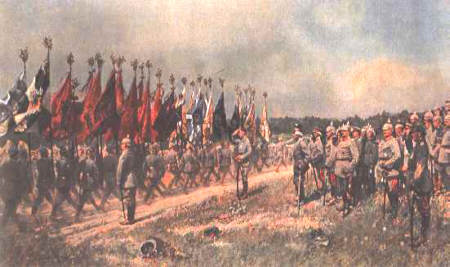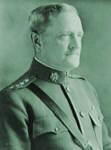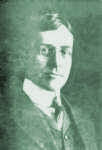The Story of the American Expeditionary Force |

General Headquarters
|
Planning the AEF:
|
A Selection from "Lafayette, We Are Here": The War College Division and American Military Planning for the AEF in World War I
by
Michael J. McCarthy

The Opposition at their Most Triumphant

Additional issues such as where best to apply American military might
would also come to the fore only after the American First
Army had deployed in France. Even more than two months
after its declaration of war, the US was gaining only a
vague hint of the degree of commitment which awaited it.
While the _Baltic_ steamed across the Atlantic, Pershing and his staff began to formulate their strategy for the role in the war. This planning seemed to develop a of its own as it grew farther and farther beyond what the military had expected. Major James G. Harbord, Pershing's Chief of Staff, remarked:
Pershing made tentative plans to have an army of at least 1,000,000 men by early spring of the following year. To achieve this end, the United States would have to ship the equivalent of four divisions per month for the next year. In addition, the supplies for such a force would call for the daily delivery to France of 25,000 tons of freight. At the time, however, the most optimistic War Department estimates concluded that by the middle of June 1918 a total of 634,975 American troops -- less than 65% of Pershing's request -- could be landed in France. Pershing did not stop at this initial request. Only a few days later, on 11 July, he wrote to Washington that even more soldiers would be desirable. He viewed his plan for 1,000,000 troops as only a "basis of study" which "should not be construed as representing the maximum force which will be needed in France." He suggested that "plans for the future should be based . . . on three times this force -- i.e., at least 3,000,000 men," a rather surreal figure which would have left the US with a force larger than the combined strength of all the belligerents in Europe. By the time Pershing began to issue his growing demands for manpower, the military planners in the General Staff seem to have yielded to Baker's wishes for the immediate shipment of more soldiers to France. On 7 June the War College Division issued a "program for the progressive dispatch of troops to France," in which the army would grow to more than 1,000,000 in the next four months and 120,000 troops per month would cross the Atlantic beginning on 1 August 1917. This force would receive its training both in North America and in Europe.
Most importantly, the War College [planners also] argued that the West was the decisive theater of the war. The sideshows in the East were just that -- sideshows. The German objective, they argued, lay with crushing France, and American involvement in the West would do the most to thwart that goal. The military planners recognized that a deadlock had existed for some time in the West, but they claimed that American involvement to the expected degree (eventually one or two million men) would tip the scales decidedly in the favor of the Entente Powers. The war would be won or lost in the West; if the United States desired to play a decisive role in the outcome of the war, and thereby earn a seat at the settlement, it would have to play that role side by side with the French and British in the trenches of the Western Front. By the end of September, the War College Division had offered its best reasoning for a western campaign, but it continued to receive suggestions for alternatives to this strategy. Even still the proposals continued to arrive. . On 11 November Baker forwarded a copy of the War College Division's memorandum of 28 September to Wilson. In his cover letter he once again reiterated the arguments against a sideshow strategy for the AEF. Hinting at Wilson's desire to have a seat at the settlement, Baker concluded by reminding the President that America's army had been "pledged for use on the Western Front in cooperation with the British and French forces there." The President finally bowed to Baker and the General Staff, but not before once again illustrating the great difference between his goals and those of the military planners. Ronald H. Spector argues that news of the November Revolution in the nascent Soviet Union and the Italian disaster at Caporetto, which had cost the Allies 40,000 casualties and a quarter-million prisoners of war, doused any ideas of alternatives. Timothy K. Nenninger, however, suggests that one argument in particular may have been decisive in the eyes of the President. The Western Front policy would allow the United States to play a major role in the war, and it therefore fit well with Wilson's political goals of reshaping Europe. While this reasoning may have convinced Wilson, the military planners themselves had already decided on this course of action months earlier for purely military reasons. Thus, while postwar politics may have entered into the final decision on whether or not to focus on the Western Front, it seems unlikely that the strategy itself was formed in the context of these considerations. In the eyes of the military planners, victory was a prerequisite for any settlement, so their sought this goal foremost. |
|
Sources and thanks: Images from the U.S. Army Chiefs of Staff page, Trenches on the Web and the Library of Congress American Memory Website. MH |
To find other Doughboy Features visit our |
Membership Information  Click on Icon |
For further information on the events of 1914-1918
visit the homepage of |
Michael E. Hanlon (medwardh@hotmail.com) regarding content,
or toMike Iavarone (mikei01@execpc.com) regarding form and function.
Original artwork & copy; © 1998-2000, The Great War Society


